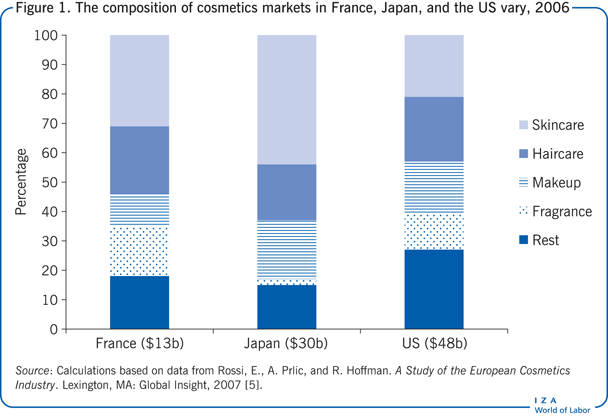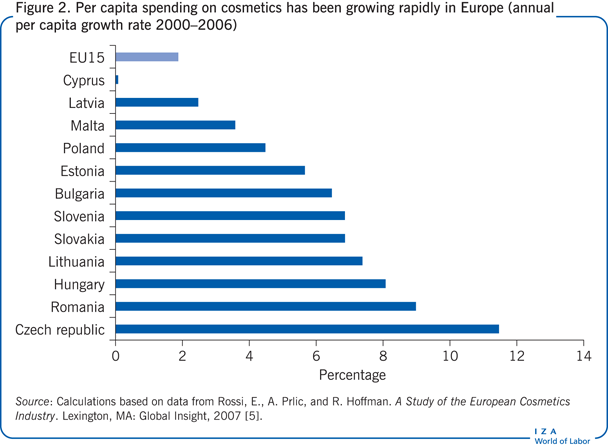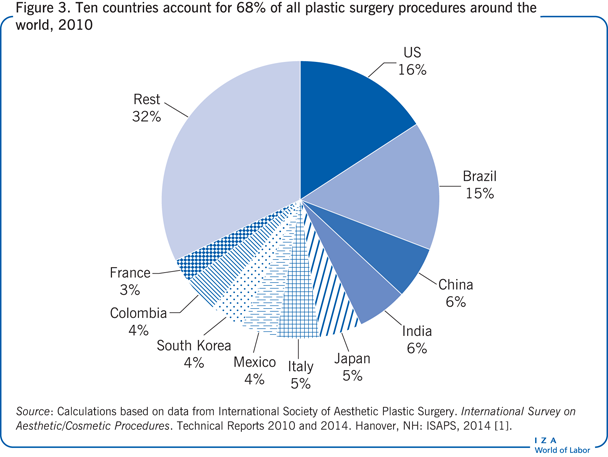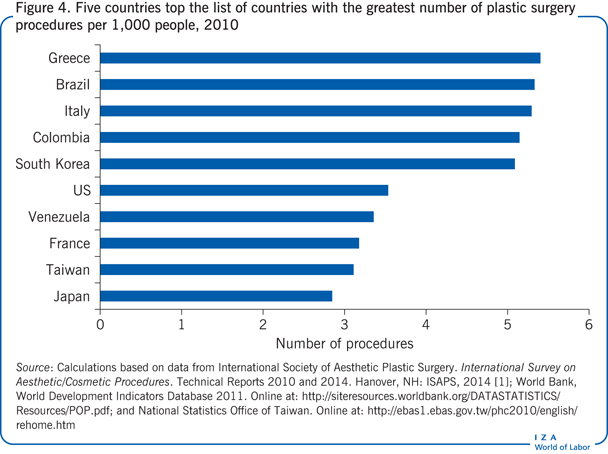Elevator pitch
Being beautiful gives a person an advantage in many settings. Attractive people earn more and have an easier time getting hired. People spend large amounts of money on goods and services to enhance their beauty. Is this enhancement worth pursuing? Research suggests that the expected improvement in beauty from these goods and services is limited. Therefore, despite the large returns from having an attractive appearance, the cost-effectiveness of investment in beauty enhancement is ambiguous. For the average person, the monetary benefits of plastic surgery, medical treatments to increase height, and expensive clothing are not worth the cost.
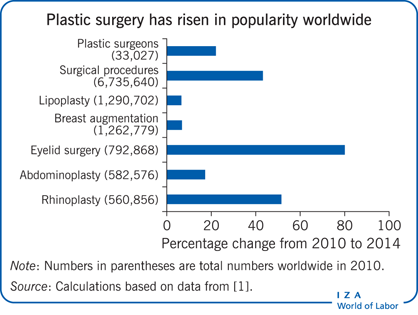
Key findings
Pros
Being beautiful gives a person an advantage in many settings, including at work and in choice of a spouse.
Plastic surgery and other beauty-related goods and services are commonly used and have been increasing in popularity around the world.
With proper measures, a person can change a wide variety of physical attributes.
Beauty-related goods and services have been found to be effective in enhancing a person’s physical attractiveness.
Achieving greater equality in beauty may diminish discrimination based on physical attributes and improve economic efficiency.
Cons
Beauty-related goods and services yield limited improvement in beauty, on average.
Some beauty-related treatments, such as plastic surgery and medical procedures to increase height, are expensive and may involve pain or discomfort and risky side effects.
Additional money spent on beauty-related goods and services may yield smaller gains in income for low- and average-income earners than for high-income earners.
On average, spending on plastic surgery, medical treatments to increase height, and expensive clothing do not yield substantial monetary gains.
Author's main message
Achieving greater equality in beauty through beauty-related goods and services may lessen discrimination based on physical attributes and thereby improve economic efficiency. Numerous such goods and services have been developed to expand the options for enhancing physical attractiveness. However, at the current stage of technology, scope for improvements in beauty remains fairly limited, and the monetary costs generally outweigh the monetary benefits. Policy interventions to develop legal measures and encourage social practices that can directly address discrimination based on physical appearance may be warranted.
Motivation
The efficient allocation of human capital is crucial for a country’s economic success. Discrimination based on characteristics irrelevant to a person’s productivity may impose a sharp cost on the efficiency of an economy. Yet numerous economic studies report that discrimination based on physical attributes is as widespread as discrimination based on gender or race/ethnicity.
Compared with other personal characteristics that can lead to discrimination, such as gender and race/ethnicity, beauty is easy to change—up to a point. People can alter their face and body using surgical procedures (such as liposuction and eyelid surgery), enhance their youthful look using non-surgical treatments (such as grooming, cosmetics, Botox, fillers), and increase their height with growth hormone therapy or surgical limb extension. Given fairly widespread beauty-based discrimination, it is important to assess the extent to which a person can mitigate such discrimination through goods and services to enhance beauty. Having this knowledge is important not only from an individual’s perspective but also from society’s, given the implications for economic efficiency.
Discussion of pros and cons
The beauty premium
People whose faces are considered very attractive enjoy considerable benefits in earnings compared with their counterparts with less attractive faces [2]. Individuals who are tall or weigh less have better labor market opportunities than their counterparts with the same productivity who are shorter or heavier [3], [4]. It is possible that the premiums associated with an attractive face and body (beauty premium) may be accounted for by other differences that are associated with beauty. For example, physically attractive people may have greater self-confidence, which may lead to greater productivity at work.
However, a growing number of studies report that beauty premiums exist even after controlling for more detailed characteristics of individuals, such as self-esteem and other personality traits. When workers in Canada and the US were classified into two groups—above-average attractiveness and below-average attractiveness—researchers found that people in the above-average group earned 12% more than people in the below-average group, a wage disparity that is comparable to those associated with race and gender [2]. The premium associated with attractive facial beauty was also found in studies in various countries, including Australia, Brazil, China, South Korea, Germany, and Luxembourg. Taller height, too, is associated with a wage premium. Each extra inch in height yields a 1.8–2.2% wage increase in the UK and the US, implying that the median wage of the tallest quarter of workers is more than 13% higher than that of the shortest quarter [3]. Being obese has negative implications for labor market outcomes. For example, if a white female worker in the US gains 65 pounds but all other factors remain the same, her wages are likely to drop 9% [4].
How much do people invest in their beauty?
Across societies and time periods, people have spent substantial resources—time, effort, and money—to enhance their beauty. A wide variety of goods and services are available for this purpose in both developing and developed countries, and the industries that produce them are large and often fast-growing. Women on average use beauty-related goods and services more than men.
Beauty-related goods and services range from grooming, hair dressing, cosmetics, and clothing that may require a modest amount of money, time, and discomfort to medical procedures, both surgical and non-surgical, that may entail higher costs across all three dimensions. Spending on these goods and services is substantial, and their markets have been growing fast.
Consider cosmetics ranging from skin care products to makeup. The market value of the cosmetics industry as of 2006 was $48 billion in the US, $30 billion in Japan, $15 billion in Germany, $13 billion in France, $11 billion in Italy, and $8 billion in Spain [5]. In the US, the cosmetics market in 2006 was composed of haircare products (22%), skincare products (21%), makeup (18%), and fragrances (12%; Figure 1). The composition of the cosmetics market in France was comparable to that in the US except that skincare products accounted for 31% of the market, 11 percentage points higher than in the US. The market in Japan in the same year featured much greater prominence for skincare products (44%) than in the US and European countries, while the share for fragrances, at just 2%, was much lower than in Western countries, where it averaged more than 10%. The composition of the cosmetics market in other Western European countries, including Germany, Italy, and Spain, was comparable to that in France, while Spain had a larger share for fragrances (23%) than the other European countries.
Among the 27 EU member countries, per capita spending on cosmetics was $161 in 2006, reflecting a 2.2% annual growth rate during the period 2000–2006 [5]. While growth in per capita spending averaged 1.9% among the 15 wealthiest EU countries, it averaged 6.8% among the 12 less wealthy EU countries (EU12) during the same period. Figure 2 shows the annual growth rate of per capita spending on cosmetics in the EU12. Growth was fastest in the Czech Republic (11.4%), followed by Romania (9.7%) and Lithuania (8.9%). All EU12 countries except Cyprus exceeded the EU15’s average growth rate. In mainland China, retail sales of cosmetics, which were valued at $8 billion in 2008, had tripled in market value just five years later [6]. Its cosmetics market composition in 2006 was comparable to that of Japan: skincare products made up the largest share (39%), followed by haircare products (22%); the market share for fragrances was less than 2% [5].
The clothing industry is considerably larger than the cosmetics industry. In 2012, its market size was $225 billion in the US, $350 billion in the EU27, $150 billion in China, and $110 billion in Japan [7]. In developing countries such as China and India, annual growth in the clothing industry is expected to top 10% over the next two decades [7]. In the US, women’s clothing accounts for 1.6% of household expenditure, while in Shanghai, China, women’s clothing together with cosmetics accounts for 6.3% of household expenditure [8].
The market for weight loss products is booming in developed countries. Examples include food-management programs consisting of pre-packaged food, weight-control supplements, and devices and services to track calorie consumption and physical activity. The market value in 2014 is expected to reach $310 billion in the US (12% annual growth from 2009) and $238 billion in Europe (11% annual growth) [9].
The plastic surgery market around the world is also large and growing. Information on market size (both sales and profits) is scarce, but in the US, total spending on both surgical and non-surgical procedures rose 13-fold between 1992 and 2014, from $927 million to $12.9 billion [1].
The use of surgical procedures that reshape a person’s face and body is the most aggressive method that can be used to improve a person’s beauty. Use of plastic surgery began to grow in the early 1910s, when it was used to treat wounded soldiers in Europe. Since then, it has exhibited remarkable expansion. In 2014, more than 33,000 plastic surgeons around the world performed more than 9.6 million surgical procedures, for a 22% increase in the number of plastic surgeons and a 43% increase in the number of surgical procedures since 2010 [1]. Women accounted for more than 85% of these plastic surgery procedures, and men for 15% [1].
The five most frequently performed plastic surgery procedures in 2014 were lipoplasty, breast augmentation, eyelid surgery, abdominoplasty, and rhinoplasty (see illustration on page 1). Liposuction removes unwanted fat deposits to improve facial and body contours. Breast augmentation changes the size and appearance of the breasts. Eyelid surgery is used for two purposes. One is to address signs of aging by tightening upper eyelid skin and reducing bags under the eyes. The other is to create an artificial crease in the upper eyelids to make eyes rounder, wider, and bigger (sometimes called “Asian eyelid surgery”). Abdominoplasty, also called “tummy tuck surgery,” removes excess skin and fat to improve the appearance of the abdominal area after pregnancy or significant weight loss. Finally, rhinoplasty improves the contours of the nose by reshaping, reducing, or enhancing the tip or nose bridge.
Figure 3 shows the top 10 countries in number of plastic surgery procedures and their share of the total number of procedures performed in 2010 [1]. The US and Brazil top the list, each with more than one million procedures; together, they account for more than 30% of plastic surgery procedures worldwide. When the data are adjusted for population size, Greece, Brazil, Italy, Columbia, and South Korea top the list of countries in the number of surgical procedures per 1,000 people (Figure 4).
Numerous non-surgical medical procedures for enhancing appearance are available and growing in popularity [1]. Examples include Botox and soft tissue fillers to ease wrinkles, and chemical peel and laser hair removal to smooth the skin. More than 10.5 million procedures were performed around the world in 2014, a 44% increase from 2010.
To what extent can beauty be enhanced?
People’s belief that beauty-related goods and services are effective in delivering what they promise supports the large and fast-growing beauty industries around the globe. That belief may be generated and reinforced by the large number of advertisements and media displays showing dramatic changes in individuals following grueling weight loss programs and plastic surgery. For example, plastic surgeons post images of their patients before and after plastic surgery procedures to show the success of the surgery. Television programs such as “Extreme Makeover” in the US and “Letmein” in South Korea give carefully selected participants an extensive list of plastic surgery procedures, with before and after videos and photos showing their dramatic changes. However, it is not clear whether such dramatic improvements are possible for average individuals. The cases highlighted publicly might not be a random sample of people who went through the same procedures, but rather those of people with the greatest likelihood of excellent outcomes.
When the objective is to acquire an attractive face, plastic surgery procedures may be expected to enhance a person’s beauty most dramatically. However, even plastic surgery is found to yield only limited improvement. Plastic surgeons in South Korea often show their clients how they will look following the surgery by using professional computer programs. Therefore, comparing how a person actually looks with a computer-generated rendering of how the person can be expected to look after plastic surgery can inform us about the probable impact of plastic surgery on facial attractiveness. A study that adopted this strategy rated people’s facial beauty in one of four categories: strikingly beautiful, above average but not strikingly beautiful, average, and the least attractive. They found that plastic surgery is effective in helping a least-attractive looking person achieve an “average” level of beauty but is unlikely to make the person strikingly beautiful [10].
Similar outcomes are found for goods and services related to weight loss and height augmentation. Not many claims for weight loss programs are backed by clinical evidence. Further, the impact of weight loss programs may be limited, considering that medical studies show that weight loss is difficult to achieve and harder to maintain over time [11]. The options for height augmentation are also quite limited. Taking human growth hormone replacement therapy or undergoing limb-lengthening surgery can increase a person’s height, but the measures are believed to be able to add no more than about three inches to a person’s height without exposing the patient to sizable health risks [3].
Evidence for the impact of clothing, grooming, and cosmetics on physical appearance is scarce. However, a few studies report some positive impacts. For example, one study finds that increasing spending on these items can enhance a person’s beauty [8]. However, the benefit of such additional spending is smaller for those who are less attractive, implying that the increase in expenditure is unlikely to make an “ugly” person strikingly beautiful.
Is investment in beauty worthwhile?
The central question here is whether the expenditure on beauty-related goods and services is worthwhile. Even if the impact of beauty-related goods and services is limited, enhancement may still be economically worth pursuing because of the substantial premiums on being beautiful. Only a handful of studies so far have conducted cost–benefit analyses on spending to enhance appearance, and all suggest that, in terms of monetary benefit, purchasing beauty-related goods and services may not be worthwhile for the majority of people [3], [8], [10].
For example, plastic surgery can help an unattractive person become average looking but not strikingly beautiful. The monetary benefits associated with being average looking are negligible, while being strikingly beautiful generates substantial benefits in terms of a person’s earnings and the likelihood of marrying a wealthy partner [10]. For example, in South Korea, being strikingly beautiful is associated with gains of 9% in earnings for men and gains of 8% for women, compared with being average looking. Being beautiful, but not strikingly beautiful, yields earnings gains of just 3% for both men and women. There is almost no difference between average-looking individuals and the least attractive individuals.
People inquiring about plastic surgery procedures consider options costing about $7,000 on average. When a person’s facial features put them in the least-attractive-looking group, such procedures offer only a 5% chance of becoming strikingly beautiful if the person is female and an almost 0% chance if the person is male. The chance of becoming “above average but not strikingly beautiful” increases to 34% for women and 2% for men. Combining these results suggests that the expected additional earnings as a result of plastic surgery for a least-attractive-looking person is a 3% increase for women and a less than 1% increase for men. Given that the average earnings in the study are about $30,000–$40,000, the monetary return to plastic surgery is not large enough to justify the cost for average-income earners. However, for example in Korea, if a person has exceptionally high earnings compared with average earnings, plastic surgery can be a valuable investment.
Similar results are found for human growth hormone replacement therapy [3]. The therapy requires treatment starting at age 10 or so, lasting 6.5 years, and costing approximately $135,000. An additional inch of height is estimated to yield a 1.9–2.7% increase in earnings, suggesting that the therapy can be justified if a person earns more than $150,000 per year for 30 years. However, median-income Americans cannot recoup the cost of the treatments even after 30 years of uninterrupted work. In addition, predicting a person’s lifetime earnings at age 10 is a difficult task, making human growth hormone replacement therapy a risky investment.
Spending on clothing and cosmetics is difficult to justify as an investment [8]. Specifically, in Shanghai, China, every additional yuan spent on beauty items in a given month increases monthly earnings by 11–15 cents, suggesting that the spending cannot be justified as an investment to improve labor market outcomes. It may instead be considered consumption or investment in non-labor market outcomes. Results for grooming are more complicated, but spending on grooming does not seem to be an investment in better labor market outcomes. One study examining whether increasing the time spent on grooming increases a person’s earnings in the US finds no significant impact on earnings—and sometimes even a negative impact—for everyone except racial/ethnic minority men [12]. This result suggests that the time and money spent on grooming have non-positive returns in earnings and thus cannot be justified.
Limitations and gaps
Although the discussion here assumes that beauty can be measured by an objective metric that receives universal agreement, it seems reasonable to believe that individuals may define beauty in different ways. However, economic studies on beauty commonly report that there is strong agreement within a society about who is beautiful. Therefore, beauty premiums and the analyses of the impact of investments in beauty are based on the average standard of beauty within a society.
The studies examined here take into account the monetary costs and benefits of investment in beauty-related goods and services. However, those are only some of the costs involved in acquiring goods and services to enhance appearance. Other costs may include the time to purchase the goods and receive the services, the cost associated with any discomfort or pain, and forgone opportunities that a person has to forfeit while acquiring the goods and services (for example, forgone wages while a person is in hospital for plastic surgery and recovery). For some beauty-enhancement measures, including plastic surgery, it is important to incorporate possible side effects or health risks—risks associated with anesthesia and neurological damage (in the case of bone reshaping, muscle removal, or liposuction, for example). Likewise, a person may gain substantial utility or self-esteem from looking more attractive, which is difficult to incorporate into cost–benefit analyses.
Using beauty-related goods and services may have long-term consequences, but there is little information on what these may be. It is possible, for example, that people with enhanced beauty may enjoy better self-esteem or attract more investment from others. If so, they may be able to accumulate human capital more quickly, suggesting that the long-term benefits can be greater than the short-term benefits.
The cost–benefit analysis does not take into account the ripple effect on employment. The large size as well as fast growth in beauty-related industries implies that they provide a sizable number of jobs and also create new jobs. For example, the clothing industry in the US employs 1.9 million people, and studies show that it has had a positive impact on regional economies across the country [13]. The plastic surgery industry is growing rapidly in both market value and number of plastic surgeons [1]. The number of plastic surgeons around the world increased from 33,000 in 2010 to 40,328 in 2014 (a 20% increase); during the same period, the growth rate was 6% in the US and 64% in South Korea. Therefore, a reduction in beauty-related investment may have negative implications for employment and local economies, at least in the short term until non-beauty industries absorb workers released from beauty-related industries.
Summary and policy advice
Having an attractive body and face can bestow various advantages on people, such as earning more or finding jobs more easily. Numerous economic studies report that the premiums associated with beauty are sizable and are found across countries. Discrimination based on physical attributes is an important factor that accounts for the reported beauty premiums. Therefore, improving beauty is a concern not only for individuals but also for policymakers, in that achieving greater equality in beauty may diminish discrimination based on physical attributes and improve economic efficiency.
Numerous goods and services have been developed and are increasing in popularity, and beauty-related industries are large and often fast-growing in both developed and developing countries. Research so far suggests that these goods and services have rather limited impact on an individual’s beauty. When it comes to plastic surgery, medical procedures for increasing height, grooming, and clothing, the monetary costs often outweigh the additional earnings a person may enjoy as a result of enhanced appearance. In addition to the monetary cost, the time the person spent on beauty enhancement and the risk of side effects and discomfort may further reduce the net benefit of investment in beauty.
The findings reported here suggest that even with investments in beauty-related goods and services, people will have difficulty circumventing discrimination based on physical attributes. Therefore, to achieve more efficient use of human capital, it is important for society and policymakers to directly address such discrimination through legal and social measures. For example, hiring practices that require job applicants to submit photographs and report their height and weight may need to be re-examined because they can unfairly diminish the job opportunities open to individuals with certain less-attractive physical characteristics. By removing such information requirements at the job application stage, a society can increase equality of job opportunity, at least up to the interview stage, at which time job applicants are better able to demonstrate their qualities beyond their appearance.
Acknowledgments
The author thanks an anonymous referee and the IZA World of Labor editors for many helpful suggestions on earlier drafts. The author also thanks Dan Hamermesh for comments.
Competing interests
The IZA World of Labor project is committed to the IZA Guiding Principles of Research Integrity. The author declares to have observed these principles.
© Soohyung Lee
